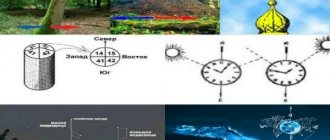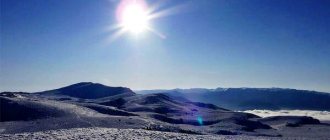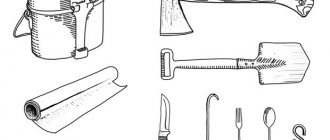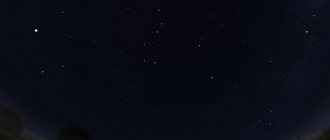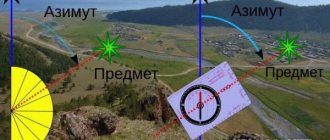What is orientation
A variety of situations can happen while traveling or walking for mushrooms. You can get lost both in a dense, dense forest and in the open steppe. In any case, in order to find your way home, you need to correctly navigate the surrounding space. This means being able to determine the sides of the horizon, your position in relation to the nearest populated areas and choose the direction of movement towards them. The foundations of this knowledge are laid in the school curriculum. For orientation in geography, there are four main directions - north, west, south and east.
Over the years of its existence, humanity has developed a large number of different methods for determining the cardinal directions. Even in ancient times, people knew the basic principle of how to navigate by the sun - the eastern direction indicates the place of its sunrise, and the western direction indicates the place of sunset. All ancient maps were oriented to the south, which was determined by the position of the sun at its zenith. For orientation in geography, there are four main directions - north, west, south and east. Over the years of its existence, humanity has developed a large number of different methods for determining the cardinal directions. Even in ancient times, people knew the basic principle of how to navigate by the sun - the eastern direction indicates the place of its sunrise, and the western direction indicates the place of sunset. All ancient maps were oriented to the south, which was determined by the position of the sun at its zenith
Ways to navigate by the sun
It would seem that everyone knows how to correctly and simply determine east and west: the sun rises and sets on these sides of the horizon. But this is not entirely accurate. To correctly determine the desired direction, you need to take into account your location - the Southern or Northern Hemisphere, since the place of sunrise and sunset by which you can navigate differs.
So, in the Northern Hemisphere, the sun rises in the east and sets in the west only on March 21 and September 23, these are the days of the spring and autumn equinox. After March 21, the sunrise location moves closer to the north, and on the day of the summer solstice (June 21), it rises in the northeast and sets in the northwest, because on this day the north pole is as close as possible to the planet Sun. When the winter season approaches, the sun sets closer to the south; on the day of the winter solstice (December 22), sunrise occurs in the southeast and sunset in the southwest. Accordingly, with regards to the Southern Hemisphere, sunrise and sunset occur exactly the opposite relative to the Northern Hemisphere. If you don’t have a mechanical watch at hand, you can use a natural “dial”.
Loading…
Video
If our planet did not revolve around the Sun and was absolutely flat, the celestial body would always be at the zenith and would not move anywhere - there would be no sunset, no dawn, no life. Fortunately, we have the opportunity to watch the sun rise and set - and therefore life on planet Earth continues.
This is interesting: Hunting for red deer: secrets of a professional
Orientation by the sun: sundial
If you don't have a mechanical watch at hand, you can use a natural "dial". The method consists in determining the cardinal directions by the shadow cast from a linear object. If you don’t have time to wait for the sun to move, you can use a faster version of this method: To do this, you need to insert a stick into the ground so that it casts a clear shadow. Mark the first mark on the ground where the shadow of the stick ends. After about 20 minutes, the shadow will move some distance, this will be the location for the second mark. It is necessary to connect the two resulting marks with a straight line, this will create an east-west axis. A tall stick determines the direction more accurately. You need to stand so that the first mark is on the left and the second on the right. Thus, you will face exactly north, with the east on your right and the west on your left. This applies to determining the sides of the northern hemisphere.
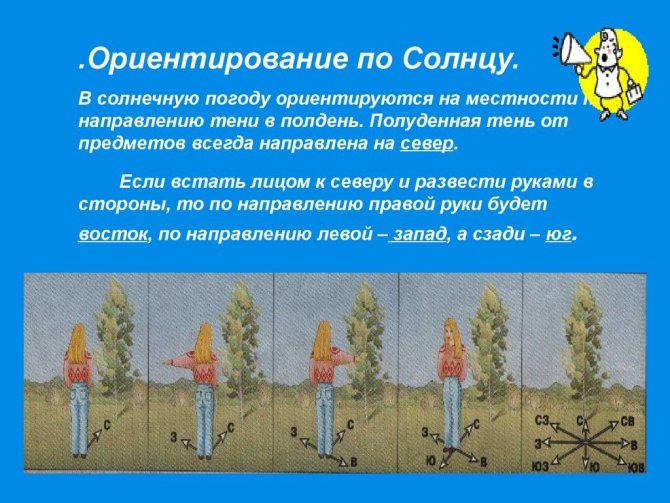
In the southern hemisphere, the shadow will point south, with west on the left and east on the right. Orientation on the ground by the sun The second version of this method is more accurate, but you can use it if you have a lot of time. Observation begins before the luminary reaches its zenith: A long stick is inserted into the ground, as in the first case, and the first mark is made. A rope is stretched between the base of the pole and the first mark, and starting from this mark, a semicircle is drawn on the ground. While the sun is rising, the time is approaching noon, the shadow from the stick will become shorter and shorter, moving away from the border of the outlined arc. The shadow moves in an easterly direction.
When the sun passes its zenith, the shadow from the stick will begin to grow until it again touches the drawn arc. This place should be marked with a second mark. Both marks are connected by a straight line, and to determine the north direction, you need to stand in the same position, similar to the previous described option. The simplest way, by analogy with the above methods, is as follows: you need to stand with your back exactly at noon to the direction of the sunlight, spread your arms to the right and left. The falling shadow will indicate the north direction, the south will be behind, the east will be on the right hand, and the west will be on the left hand. Do not forget that, in the southern hemisphere, the falling shadow, on the contrary, indicates the southern direction.
Noon
The fact that it is not the Sun that revolves around the Earth, but rather the opposite, became finally clear only by the middle of the 16th century. Moreover, one of the people who expressed this idea (Copernicus) was so sure that it contradicted the obvious - what can be observed every day, that he prefaced his publication about the heliocentric system with words about its obvious absurdity.
Now even a schoolchild knows that in fact the movement of the solar disk across the sky is the result of the Earth’s rotation around its axis, that our planet makes one full revolution per day, that the position of the sun above the horizon at a particular moment in time depends not only on the angle of rotation to the body. It is influenced by the position occupied by the Earth during its annual revolution around the Sun. In winter in the northern hemisphere, our star rises lower at noon than in summer.
According to the position of the Sun
There are situations when understanding the location of the cardinal directions does not play a special role, for example, if a person gets lost in an unfamiliar area, for example, in a forest, there is no map and he does not know the emergency azimuth. In this case, the Sun will help you move in one direction, and not zigzag. And clearly maintaining the direction of movement, provided that it is possible to move in azimuth (the absence of dense undergrowth and other difficult obstacles) will help you get to a clearing, path, stream, highway, railway as quickly as possible and with the least energy costs - everything that will help you reach people.
On a note
I have often come across information that without landmarks a person in the forest will walk in circles, returning to his original place. In this case, they also say that “the devil is twisting.” There is even an approximate radius of the circle that a person will describe as a result of his movement. The authors of these statements attribute this effect to the fact that one human step is always shorter than the other. However, if you conduct a real experiment in which a person tries to move in a straight line blindfolded, it will immediately become clear that the information described has little in common with reality. In an experiment at a short distance, the same person, as a result of a series of experiments, will shift either to the left or to the right of a given movement, and in experiments with long distances, the trajectory of the person’s movement will describe zigzags.
This method of orientation works according to the following algorithm:
- The angle (“azimuth”) of the direction of movement relative to the position of the Sun at a given moment is determined.
- There is a landmark (for example, a bush, stone or tree) lying in the direction of movement and located as far as possible from the person.
- Having moved to this landmark, the direction of further movement, at which the next landmark is located, is specified using the Sun and the previously determined angle.
- Thus, movement occurs from landmark to landmark. At the same time, adjustments are made to the “azimuth” from time to time, taking into account the speed and direction of the Sun’s movement in this area.
If the Sun is in front of a person’s face, to the left or to the right of him, then it is convenient to measure the angle relative to the projection of the Sun onto the horizon. If the Sun is behind your back, which creates some difficulties when calculating the angle directly from the Sun, then this angle is measured not from the Sun, but from the shadow cast by a person.
This orientation also allows you to conduct reconnaissance of the area in different directions, reducing the chances of getting lost, which is most important in the forest. For this:
- A clearly visible landmark is left at the starting point (for example, sticks folded into a pyramid or a bright piece of fabric tied to a tree branch).
- From this landmark, a person moves within a minute in the chosen direction, having previously determined its “azimuth”.
- After a minute, the person turns 180 degrees and moves in the opposite direction in reverse azimuth.
- Having reached the abandoned landmark, a new direction is selected that needs to be explored, and the whole procedure is repeated.
In this method, it is convenient to use the “azimuth” determined both by the Sun and by the shadow. So, for example, if during movement from a landmark, the Sun was to the right of the direction of movement at an angle equal to 15 degrees, then when returning to the landmark, you need to choose the direction of movement so that the shadow was to the right by the same 15 degrees.
This method of orientation is very approximate and, as mentioned earlier, is intended for emergency situations when a person does not care where to go, as long as in one direction.
At the same time, this method is perfectly combined with gnomon orientation methods. So, having orientated yourself on the terrain using the gnomon just once and choosing the desired direction of movement, you can use this method throughout the next daylight hours. It is important to note that to reduce the error, using this method, you need to move approximately the same number of hours, both before and after lunch. For example, if the movement began at 8 o'clock in the morning, then the movement must end at 4 o'clock in the evening. This, of course, does not mean that the movement should be continuous without rest, however, both the speed of movement and the time for rest in the morning and evening should be approximately the same. In addition, you can move, for example, from 7 am to 10 pm, and after that from 2 pm to 5 pm.
I think we have figured out how to determine the cardinal directions from the Sun, and now I would like to talk a little about how to calculate your coordinates from the Sun. This topic is not very popular and many tourists are not aware of it at all, but since determining your position directly relates to the topic of orientation, I see no reason not to consider it.
Determination of azimuth and longitude direction from the measured zenith distance of the Sun
The basis for determining longitude from observations of the Sun is the second theorem of spherical astronomy: the difference in local times is equal to the difference in longitudes, or
l=m-UT.
where is Universal Time UT?
UT=Dn–(n+k)= Tn+u-(n+k)
and mean solar time is determined by the hour angle of the true Sun. How
m= t- E, where E is the equation of time.
The azimuth of the direction to an earthly object based on observations of the Sun is calculated using the usual formula:
am= A+ Q
where Q is the measured horizontal angle.
The hour angle t and the solar azimuth A can be calculated from the solution of the parallactic triangle. in which the latitude j and the solar declination d are known, as well as the zenith distance Z:
Cos t= (cosZ — sinj*sind)/cosj*cosd = K
Cos A= (sinj*cosZ — sind)/cosj*sinZ = L
The value of the circular angle is determined depending on the position of the luminary relative to the meridian. If the Sun is observed west of the meridian (evening observations), then
t= arccos(K), A=arccos(L),
and if the Sun is east of the meridian, then
t= 360 — arccos(K), A=360 — arccos(L),
The equation of time E and the declination of the Sun d are interpolated from the Astronomical Yearbook to the average moment of observation in reception using formulas with hourly changes:
d= d0+ vd(UT)h, E= E0+ vE(UT)h
where d.Eo are tabulated coordinate values on the observation date;
vd, vE—their hourly variations.
The direction azimuth according to the zenith distance of the Sun is determined in the morning and evening hours when the Sun's altitude is at least 10°. To observe the Sun, it is necessary to have a clock, the correction of which relative to the daylight time of a given zone must be known with an error not exceeding 2m. Observation of the Sun in each technique is performed in the following order. 1) With a circle left (right): pointing the pipe at an earthly object; recording readings along the horizontal lim00b; pointing the telescope at the Sun; recording of readings by the hour (up to whole minutes), by vertical and horizontal dials.
2) With a circle to the right (left): pointing the pipe at the Sun; recording of readings by the clock, by vertical and horizontal dials; pointing the pipe at an earthly object; recording of readings along the horizontal dial.
Observations of the Sun are made with a light filter. After the image of the Sun has entered the field of view of the telescope, the horizontal thread of the grid is brought by the guiding screw of the tube to the upper or lower edge of the solar disk. By rotating the guiding screw, the edge of the Sun's disk is held on this thread until the image of the lateral edge of the Sun's disk touches the vertical thread. At the moment of contact, readings from the clock and the vertical and horizontal limbs of the theodolite are taken and recorded in the journal. With CL and CP, the image of the solar disk is observed in opposite corners of the grid of pipe threads. In this case, the average of the readings along the vertical and horizontal limbs will be referred to the center of the Sun. The zenith distance of the Sun is corrected by corrections for refraction and daily parallax, i.e. Z =Z' +r -P, where P = 9″sinz'.
DETERMINATION OF AZIMUTH BY THE HOUR ANGLE OF THE SUN
The most favorable conditions for determining azimuth from the hour angle of the Sun are morning and evening hours, when the zenith distance of the Sun is sufficiently large. In practice, to determine the azimuth of the Sun it is necessary to observe at zenith distances from 50 to 80°. An error in the Sun's hour angle in ts can result in an error in azimuth of up to 15″. Thus, when determining azimuth from the hour angle of the Sun, the observation time must be known with great accuracy. For example, to determine the astronomical azimuth of a direction with an error of 10″, the astronomical longitude of a point and the clock correction must be known with an error not exceeding 0.35. Bearing in mind that during observations with the eye-ear method of the same order there may be a constant part ΔT of the error of the moment Tn of observing the Sun, it hardly makes sense to talk about determining the azimuth using the eye-ear method based on the hour angle of the Sun with an accuracy exceeding 10 ″. The general observation procedure, as in other methods related to determining the hour angles of luminaries, is as follows: receiving radio time signals; determination of the azimuth direction to an earthly object from observations of the Sun; reception of radio time signals. To determine the astronomical azimuth with an error of 10″, it is enough to make 3-4 observations using an optical theodolite and a two-hand stopwatch. Each azimuth observation technique is performed in the following order.
P r i g e l e v o (right):
· Pointing the pipe at an earthly object: recording readings along the horizontal limb;
· Pointing the telescope at the Sun (before pointing the telescope, a light filter is put on the eyepiece), observing the moments of the passage of the left (right) edge of the Sun through three vertical threads using the “eye-key” method; recording moments T; by stopwatch; recording of invoice level readings on the horizontal axis (the level and theodolite must be protected from sunlight at all times); recording readings on the horizontal dial; counting along the vertical dial with an accuracy of 1 '.
P r u g e r r a v o (left):
· Observation of the other edge of the Sun in the same way as in the first position of the theodolite;
· Pointing the pipe at an earthly object, recording the readings of the horizontal limb.
Computing. Corrections and progress of the second measure (hours) from the reception of radio time signals, depending on the adopted methodology for calculating the hour angle of the Sun, can be calculated in the system of local sidereal or mean time with a known longitude of point λ. Calculation of corrections and movement of the stopwatch relative to local time is carried out according to the formulas: Calculation of corrections and movement relative to local average time is carried out according to the formula: where In the observation log, the average moment of observations of the Sun in half-reception and in reception, the difference in the zenith distance of the Sun in reception (up to minutes) is calculated.
correction of the horizontal direction to the Sun for the tilt of the horizontal axis horizontal direction on to a local object horizontal direction to the Sun horizontal angle between the Sun and a local object The azimuth of the Sun is calculated with the average moment of observation in reception using the formulas where where and are selected from the tables adj. 2. The hour angle of the Sun can be calculated: according to local sidereal time according to local mean time. The declination of the Sun, its right ascension and the equation of time E are interpolated from the tables of the Sun AE at the moment of ephemeris time. The astronomical azimuth of the direction to the local object from each reception is calculated using the formula Transition to horizontal azimuth can be carried out using Laplace's formula (if the geodetic longitude of the point is known) or according to the scheme of deviations of the plumb line and corrections to astronomical azimuth directions.
By the end points of two shadows
This method is based on the understanding that the Sun always moves from east to west, which means the shadow will move from west to east. If you mark two positions of the end of the gnomon's shadow with an interval of 15–20 minutes, and then connect the two marks made, the resulting segment will be located in the west-east direction.
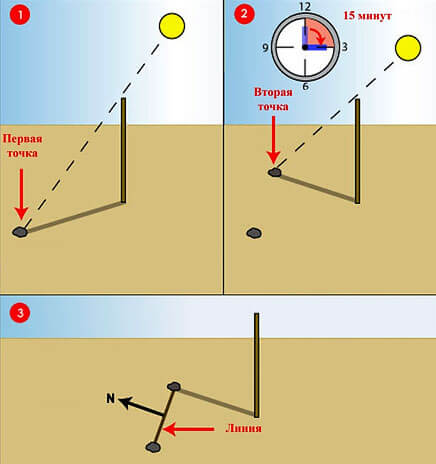
To implement this method, you do not need to wait all day until the shadow in the evening acquires the same length as in the morning - just two points marking the ends, at a more or less significant distance, are enough.
This method allows you to navigate by the Sun without a watch for a short period of time, but can give significant errors on days far from the dates of the spring and autumn equinoxes. If you have to use this method in summer or winter, then it is better to do it during lunch hours: closer to noon, the magnitude of the method error decreases. This is especially true for high latitudes on a polar day, when determining the cardinal directions by this method at 12:00 and 24:00 will give diametrically opposite readings, that is, for example, where south was determined at noon, north will be determined at midnight and vice versa .
Atmosphere of the Sun
Since the temperature of the upper layers of the Sun exceeds 6 thousand degrees Celsius, it is not a solid body: at such a high temperature, any stone or metal is transformed into gas. Scientists came to such conclusions recently, since previously astronomers had suggested that the light and heat emitted by a star are the result of combustion.
The more astronomers observed the Sun, the clearer it became: its surface has been heated to the limit for several billion years, and nothing can burn for that long. According to one of the modern hypotheses, the same processes occur inside the Sun as in an atomic bomb - matter is converted into energy, and as a result of thermonuclear reactions, hydrogen (its share in the composition of the star is about 73.5%) is transformed into helium (almost 25%) .
Rumors that the Sun on Earth will sooner or later go out are not without foundation: the amount of hydrogen in the core is not unlimited. As it burns, the outer layer of the star will expand, while the core, on the contrary, will shrink, as a result of which the life of the Sun will end and it will transform into a nebula. This process will not begin soon. According to scientists, this will happen no earlier than in five to six billion years.
As for the internal structure, since a star is a gaseous ball, the only thing it has in common with a planet is the presence of a core.
Core
It is here that all thermonuclear reactions occur, generating heat and energy, which, bypassing all subsequent layers of the Sun, leave it in the form of sunlight and kinetic energy. The solar core extends from the center of the Sun to a distance of 173,000 km (approximately 0.2 solar radii). Interestingly, in the core the star rotates around its axis much faster than in the upper layers.
Radiative transfer zone
Photons leaving the nucleus in the radiative transfer zone collide with plasma particles (ionized gas formed from neutral atoms and charged particles, ions and electrons) and exchange energy with them. There are so many collisions that it sometimes takes about a million years for a photon to pass through this layer, and this despite the fact that the plasma density and its temperature at the outer boundary decrease.
Tachocline
Between the radiative transfer zone and the convective zone there is a very thin layer where the formation of a magnetic field occurs - the electromagnetic field lines are stretched by plasma flows, increasing its intensity. There is every reason to believe that here the plasma significantly changes its structure.
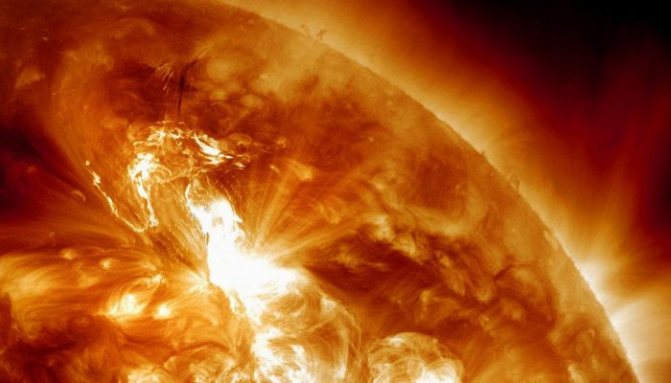
Convective zone
Near the solar surface, the temperature and density of matter becomes insufficient for the solar energy to be transferred only through re-radiation. Therefore, here the plasma begins to rotate, forming vortices, transferring energy to the surface, while the closer to the outer edge of the zone, the more it cools, and the gas density decreases. At the same time, the particles of the photosphere located above it, cooled on the surface, go into the convective zone.
Photosphere
The photosphere is the brightest part of the Sun that can be seen from Earth in the form of the solar surface (it is called so conventionally, since a body consisting of gas does not have a surface, so it is classified as part of the atmosphere).
Compared to the radius of the star (700 thousand km), the photosphere is a very thin layer with a thickness of 100 to 400 km.
It is here that, during solar activity, light, kinetic and thermal energy is released. Since the temperature of the plasma in the photosphere is lower than in other places, and there is strong magnetic radiation, sunspots form in it, giving rise to the well-known phenomenon of solar flares.

Although solar flares do not last long, an extremely large amount of energy is released during this period. And it manifests itself in the form of charged particles, ultraviolet, optical, x-ray or gamma radiation, as well as plasma currents (on our planet they cause magnetic storms that negatively affect human health).
The gas in this part of the star is relatively thin and rotates very unevenly: its rotation in the equator region is 24 days, at the poles - thirty. In the upper layers of the photosphere, minimum temperatures are recorded, due to which out of 10 thousand hydrogen atoms only one has a charged ion (despite this, even in this region the plasma is quite ionized).
Chromosphere
The chromosphere is the upper shell of the Sun, 2 thousand km thick. In this layer, the temperature rises sharply, and hydrogen and other substances begin to actively ionize. The density of this part of the Sun is usually low, and therefore is difficult to distinguish from the Earth, and it can only be seen in the event of a solar eclipse, when the Moon covers the brighter layer of the photosphere (the chromosphere glows red at this time).
Crown
The corona is the last outer, very hot shell of the Sun, which is visible from our planet during a total solar eclipse: it resembles a radiant halo. At other times it is impossible to see it due to its very low density and brightness.
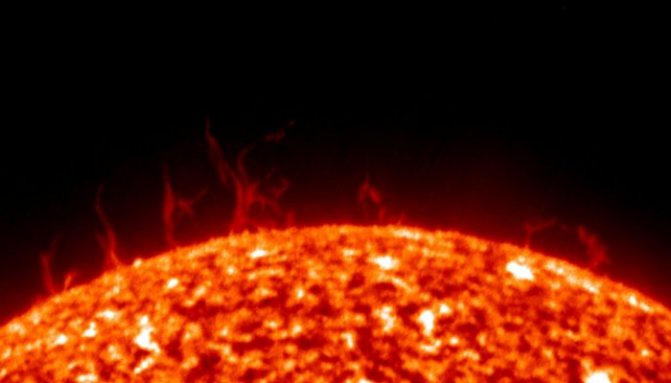
It consists of prominences, fountains of hot gas up to 40 thousand km high, and energetic eruptions that go into space at great speed, forming the solar wind, consisting of a stream of charged particles. It is interesting that many natural phenomena of our planet, for example, the northern lights, are associated with the solar wind. It should be noted that the solar wind itself is extremely dangerous, and if our planet was not protected by the atmosphere, it would destroy all living things.
Solar orientation in cloudy weather
Orientation based on the sun is possible even in cloudy weather. This is done with the help of shadows that cast objects in the summer even in the absence of sunlight. This method allows you to determine the east-west line. It is necessary to stick a long stick (about forty centimeters) into the ground so that it does not cast a shadow: this means that its top points to the sun. Next, you need to wait until it begins to cast a shadow again, and, as the shadow moves, place pebbles where the end of the stick on the ground pointed.
Thus, it turns out that the shadow will move from west to east, from the first pebble placed to the second. The north-south line is determined perpendicular to the west-east line. Orientation by the sun is possible even after sunset: on summer nights, relative to northern latitudes, from the close position of the setting luminary to the horizon, the northern side of the sky becomes lighter, and the southern side becomes darker. Despite the apparent complexity, methods of orientation in the area relative to the daylight allow, without interrupting your hike, to determine the correct direction relative to the cardinal points, familiar objects, as well as determine your own location relative to populated areas or familiar landmarks. It is only necessary to take into account the correctness of the calculations, as well as maternity time.
The only star in the solar system
Some may be surprised to learn that the Sun is not a planet. The sun is a huge, luminous ball of gases, inside of which thermonuclear reactions constantly occur, releasing energy that gives light and heat. It is interesting that such a star does not exist in the solar system, and therefore it attracts to itself all smaller objects that are in the zone of its gravity, as a result of which they begin to rotate around the Sun along a trajectory.
Naturally, in space the Solar System is not located on its own, but is part of the Milky Way, a galaxy that is a huge star system. The Sun is separated from the center of the Milky Way by 26 thousand light years, so the movement of the Sun around it is one revolution every 200 million years. But the star rotates around its axis in a month - and even then, these data are approximate: it is a plasma ball, the components of which rotate at different speeds, and therefore it is difficult to say exactly how much time it takes for a full rotation. So, for example, in the equator region this happens in 25 days, at the poles - 11 days more.
Of all the stars known today, our Sun is in fourth place in terms of brightness (when a star exhibits solar activity, it shines brighter than when it subsides). By itself, this huge gaseous ball is white, but due to the fact that our atmosphere absorbs short-spectrum waves and the Sun’s ray at the Earth’s surface is scattered, the light of the Sun becomes yellowish, and the white color can only be seen on a clear, fine day against the background blue sky
Why does the wind blow?71554.361

Being the only star in the Solar System, the Sun is also the only source of its light (not counting very distant stars). Despite the fact that the Sun and Moon are the largest and brightest objects in the sky of our planet, the difference between them is huge. While the Sun itself emits light, the Earth's satellite, being a completely dark object, simply reflects it (we can say that we also see the Sun at night when the Moon illuminated by it is in the sky).
The Sun was shining - a young star, its age, according to scientists, is more than four and a half billion years. Therefore, it refers to a third generation star, which was formed from the remains of previously existing stars. It is rightfully considered the largest object in the solar system, since its weight is 743 times greater than the mass of all the planets revolving around the Sun (our planet is 333 thousand times lighter than the Sun and 109 times smaller than it).
Natural landmarks
If it is a cloudy day, you can use other landmarks available in the forest, since it is not possible to navigate by the sun. Trees can tell you where is north and where is south. Lichens and moss usually cover the northern side of their trunk. The sun's rays dry out the moisture on the southern side of the trees quite quickly, so the lichen has no chance of surviving.
In addition, the branches on the south side of the tree are longer and denser. It will help to determine the sides of the horizon and an ordinary anthill. Usually it is located on the south side of the tree, because otherwise a shadow would fall on it. Ants need sunlight. In addition, the slope of the anthill on the north side is steeper. Natural landmarks must be used in combination, without relying on any one. If you carefully look at the surrounding objects, and also know how to navigate by the sun and compass, any trip to the forest will definitely end happily.

